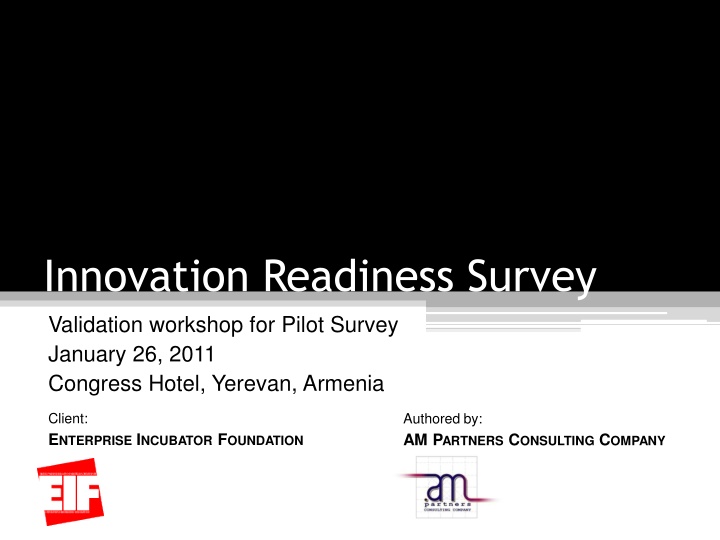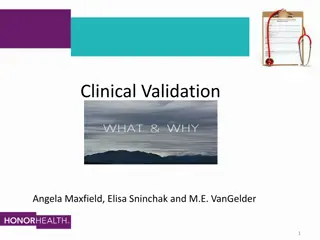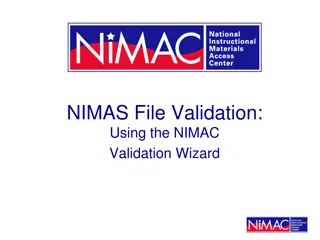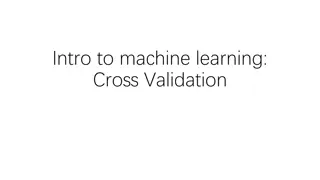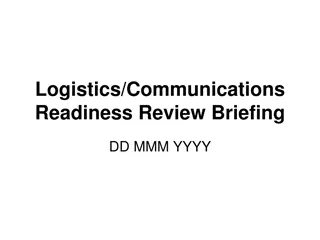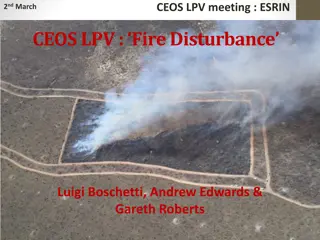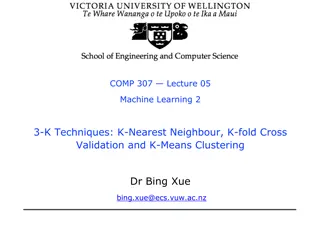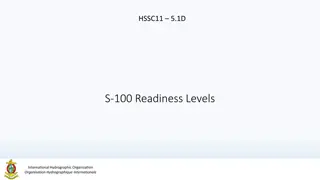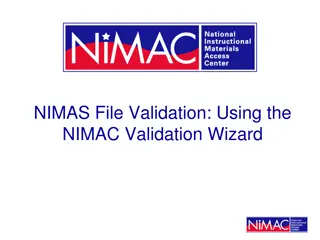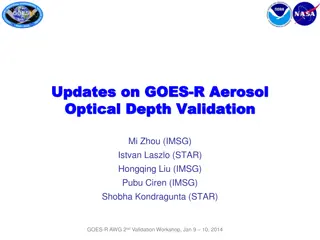Innovation Readiness Workshop Validation for Pilot Survey
This workshop, held in Yerevan, Armenia, focused on validating the innovation readiness survey for conducting pilot surveys. The project objectives included defining technology innovation, developing a methodological framework, and identifying priority economic sectors. The workshop also aimed to present the work to date, discuss preliminary findings, and gather feedback on scope and methodology from key stakeholders. Notable progress had been made through interviews, desk research, and collaboration with various experts. The analysis would concentrate on innovation-related aspects within enterprises, excluding broader economic and policy considerations.
Download Presentation

Please find below an Image/Link to download the presentation.
The content on the website is provided AS IS for your information and personal use only. It may not be sold, licensed, or shared on other websites without obtaining consent from the author.If you encounter any issues during the download, it is possible that the publisher has removed the file from their server.
You are allowed to download the files provided on this website for personal or commercial use, subject to the condition that they are used lawfully. All files are the property of their respective owners.
The content on the website is provided AS IS for your information and personal use only. It may not be sold, licensed, or shared on other websites without obtaining consent from the author.
E N D
Presentation Transcript
Innovation Readiness Survey Validation workshop for Pilot Survey January 26, 2011 Congress Hotel, Yerevan, Armenia Client: ENTERPRISE INCUBATOR FOUNDATION Authored by: AM PARTNERS CONSULTING COMPANY
2 Project Objectives and Deliverables Project Objectives Final Deliverables Definition of Technology Innovation Define Technology Innovation (TI) and its components Detailed methodological framework for conducting survey Identify relevant methodology to measure TI in firms Recommendation on priority economic sectors to conduct survey Identify Priority economy sectors for assessment survey Survey instruments (Questionnaire) Develop sample design and identify principles of selection Technical report on pre-test results Design survey instruments Implement pilot interviews with 30-40 companies Source : TOR
3 Goals of today s meeting Presentation of the work to date Presentation and discussion of preliminary findings: Scope and definition of Technology Innovation Methodological framework Questionnaire Discussion on Target economic sectors Get your feedback
4 What has been done so far - To date 26th January - Interviews Desk Research Preliminary results Vahe Danielyan - Deputy Minister of Economy Definition of Innovation Technology OECD World Bank WIPO EuroStat INSEAD London SE UN Statistics Division Countries statistical Bureaus Internet etc Karen Vardanyan Head of UITE Methodology Questionnaire Artak Ghazaryan Head of USAID CAPS Project Classification of sectors Samvel Harutunyan Head of State Committee on Science Recommendation on sectors Karen Grigoryan WB Task Team Leader
5 Provisions on the Scope of analysis The scope of analysis is the ENTERPRISE level and not the country level Innovation Indexes only exist on a national level. This project will not provide an index as such, but a measurement instrument in the form of a questionnaire to evaluate the innovation readiness of Armenian companies International benchmarks are relevant if they are done on a specific economy sector (Software, Mining, etc...) and under the condition that the basis of measurement (questionnaire) uses compatible indicators between countries The analysis will only focus on innovation-related issues within the framework of the interviewed enterprises. Issues pertaining to policies, infrastructure, economic environment, etc...will not be taken into account BOTTOM-UP APPROACH
6 Framing the concept of Innovation - Pillars of competitiveness - Basic Requirements Institutions Infrastructure Macroeconomic environment Health and primary education Pillars of Competitiveness Innovation Readiness is a sub-element of competitiveness Efficiency Enhancers Higher Education and Training Goods market Efficiency Labor and market efficiency Financial Market development Technical Readiness Market Size PROJECT FOCUS: Technological Innovation Only Innovation and Sophistication Factors: Business Sophistication Innovation Source : WEF Global Competitiveness Report, Interviews, AM Partners Analysis
7 Framing the approach of the project - A six-step approach to the project - 1 3 4 5 6 Global Approach to Innovation Method Framework For National Survey Design Survey Instrument Survey Methodology Pilot Survey Specificities of RA 2 The aim of this project is to build and test a methodology and framework to evaluate innovation readiness of Armenian companies and NOT to provide statistically valid results and conclusions Source : AMPartners
8 Framing the approach of the project Based on standard of national innovation surveys conducted in the EU countries to benefit from 20 years of best practices : Community Innovation Surveys (CIS) Based on guidelines of the Oslo Manual in order to get comparable results across countries Adjustments to the specifics of Armenian situation have been included and documented in a way to maintain comparability with other countries Final version of the methodology will be validated at the end of the project i.e. after the pilot survey on 30-40 companies
9 Presentation of methodology 1. Definitions and scope 2. Classification and sampling 6. Economy sectors Methodology Framework 3. Data collection 5. Questionnaire design 4. Analysis of results Source : Oslo Manual, Interviews, AMPartners Analysis
10 Definitions and scope (1/3) An innovation is the implementation of a new or significantly improved product (good or service), or process, a new marketing method, or a new organizational method in business practices, workplace organization or external relations. For the purpose of this project, Technological Innovations will only cover product and process innovation activities. Source : Oslo Manual
11 Definitions and scope (2/3) A product innovation is the introduction of a good or service that is new or significantly improved with respect to its characteristics or intended uses. This includes significant improvements in technical specifications, components and materials, incorporated software, user friendliness or other functional characteristics. A process innovation is the implementation of a new or significantly improved production or delivery method. This includes significant changes in techniques, equipment and/or software. Source : Oslo Manual
12 Definitions and scope (3/3) -The below are EXCLUDED from the scope Marketing innovations that are the implementation of new marketing methods involving significant changes in product design or packaging, product placement, product promotion or pricing. Organizational innovations that are the implementation of new organizational methods in a firm s business practices, workplace organization or external relations. Source : Oslo Manual, Interviews, AMPartners Analysis
13 Classification and sampling (1/4) Given the lack of adequate statistics and classification data, we shall have two different approaches according to the context of the survey 1 2 In the context of this PILOT PROJECT In the context of the NATIONAL survey
14 Classification and sampling (2/4) 1 PILOT PROJECT - Two main criteria of classification for Enterprises - By Size By Activity The International Standard Industrial Classification (ISIC)* Size will be measured on the basis of the number of employees 1-9 10-49 50-99 100-249 250-499 500-999 1 000-4 999 The statistical classification of economic activities in the European Community (NACE) Use of correspondence tables when necessary Source : Oslo Manual (*): Cf. Annex 1
15 Classification and sampling (3/4) 1 PILOT PROJECT 40 enterprise interviews will be scheduled Although the results of this analysis will not be statistically relevant, the sample is large enough to validate the efficiency of the survey instrument (Questionnaire) The priority will be on the most innovation-centric sectors that will not necessarily be representative of RA economy as a whole : 80% of respondents will be in ICT and engineering sectors (approx 30 companies) as they are clearly the most innovation-intensive sectors and by nature, have the data required to test the questionnaire 20% of respondents will be in non-ICT sectors (approx. 10 companies) to test the validity of the questionnaire in other contexts The selection of the sectors and companies will be detailed in chapter 6 of this presentation.
16 Classification and sampling (4/4) 2 NATIONAL SURVEY The criteria by size will remain the same The criteria by activity will need to be more detailed. Some activities will need to be broken into more sub-segments to provide more visibility to stakeholders on where innovation is happening: e.g. Engineering Robotics Programming Precision Mechanics Electronics Lastly, the sample of the survey (200 enterprise +) will need to reflect the realities of the Armenian economy. The proposed model will be explained in chapter 6.
17 Collection of innovation data Data collection will focus on the innovative behavior and activities of the enterprise as a whole : explore the factors influencing the innovative behavior of the firm (strategies, incentives and barriers to innovation) get some idea of the inputs and outputs and effects of innovation. Data collection will be conducted through personal interviewsby senior consultants to capture efficiency of survey instrument. At this stage we are planning on one interview per company unless a specific case justifies carrying out two or more in the same organization. Client will be consulted in this situation. Respondent profiles : we will focus on meeting with the most knowledgeable contact in innovation. Depending on size and type: Managing Director Head of R&D / Head of Institute Chief Engineer Other
18 Analysis of results The survey instrument will generally comprise of 4 types of questions: (a) open questions (b) scaled questions (Likert scaling : strongly agree / disagree moderately agree / disagree) (c) single choice questions (yes/no answers) (d) output / hard data questions The questionnaire will aim to capture : Standardised data based on the CIS model Specific data relevant to RA and RA R&D activity Soft data on cultural readiness and factors facilitating innovation The questionnaire will be comprised of : 13 Sections 55 Indicators
19 Questionnaire : 13 sections (1/2) What is the firm s profile? : Industry, # employees, Ownership, active markets, hard data on activity Section 1 The enterprise What innovations did the firm develop? : List and types of innovations: where they were developed, are they new to the firm or new to Armenia, where are they applied, % in activity Sections 2 and 3: Product and process innovation How did the firm invest in innovation? : Analysis of split between In-house RD, External, Acquisition of expertise/ patents / machinery / technology, Pulic funding Section 4: Innovation expenditure What type of R&D is available? : Types and fields of R&D, Size and split of teams What is level of patent activity? : Patents filed, granted, acquired, technological fields Sections 5 & 6: Focus on R&D and patents
20 Questionnaire : 13 sections (2/2) Is open innovation developed in the firm? : Importance of sources of information by type, Geographical distribution of sources, examples. Section 7: Cooperation and information Section 8: Why do firms innovate? : Ranking of different reasons and relevance for the future Innovation objectives Section 9: How do firms protect their innovations? : Ranking of different methods Innovation protection What prevents firms from innovating? Analysis of reasons for abandoning innovation, ranking of hindering factors for innovation, reasons for non existence of innovation Sections 10, 11, 12: Innovation constraints Do firms have the right mindset to innovate? Soft analysis of perception of innovation readiness Section 13: Cultural readiness
21 Questionnaire : 55 indicators - Number of indicators - Hard Data Survey Data Section 1 Section 2, 3 Section 4 Section 5, 6 Section 7 Section 8 Section 9 Section 10, 11, 12 Section 13 3 2 7 9 - - - - - 5 5 2 6 4 1 1 5 5 TOTAL 21 TOTAL 34 21
22 Economy sectors RD Inst. ICT BioTek SMALL MEDIUM LARGE SUPPLY SIDE DEMAND SIDE
23 Economy sectors : Pilot (1/2) RD Inst. ICT/Eng Other SMALL 10 3 40 MEDIUM 10 4 Companies LARGE 10 3 SUPPLY SIDE DEMAND SIDE Source : Interviews, AMPartners Analysis
24 Economy sectors : Pilot (2/2) - Examples of players for PILOT- SUPPLY DEMAND R&D institutes ICT ArmenTel Orange Vivacell Abide Web Technologies Smart Systems Small 1 to 9 Synopsys Industrial Technologies Viasphere Technopark Alikhanian National Science Laboratory Yerevan Telecom Research Institute etc Medium 10 to 49 Industrial Engineering A2 Limited Leda Systems National Instruments Pharmaceuticals Vitamax-e Arpimed Liqvor Large Above 49
25 Economy sectors : National (1/4) - Approach to choosing economy sectors - State Priorities International Markets Soviet Heritage
26 Economy sectors : National (2/4) The survey will focus on the sectors with high innovation potential. The best indicators for innovation potential/activity with standardized and available data are patent filing statistics WIPO has defined standardized innovation related technological fields that have been categorized in Annex 2. There are correspondence tables between these fields and NACE/ISIC classifications. We suggest to use the available WIPO international statistics as indicators for the best sectors to focus innovation readiness on and cross-analyze them with stakeholder opinions and RA specifics to determine the priority sectors for the national survey.
27 Economy sectors : National (3/4) - WIPO : 30 classified technological fields - 1 860 000 920 000 7.8% Computer Technology 49% Electronic Machinery 6.5% Half of world-wide innovation efforts (filed IP patents) are concentrated on 10 technological fields 5.0% Telecommunications 4.8% 4.5% 4.4% 4.3% 4.3% 4.2% 3.7% Semiconductors Audio-Visual Technology Optics Medical Technology Transport Measurement Pharmaceuticals - Total number of patents filed -by field of technology in 2007 Worldwide 27 Source : WIPO, AM Partners Analysis
28 Economy sectors : National (4/4) CAGR of nbr. of patents filed by field of technology -between 2000-2007 Wwide 16% 16% TOP FIVE FASTEST GROWING SECTORS: 14% 12% 10% 9% 8% 7% 8% 7% 1. NanoTech 2. Digital Com 3. Computer 4. Semiconductors 5. Food Industry 6% 6% 6% 6% 6% 6% 5% 5% 5% 5% 5% 4% 2% 0% Electrical machinery, apparatus, Audio-visual technology Digital communication Engines, pumps, turbines Semiconductors Optics Surface technology, coating Pharmaceuticals Telecommunications Medical technology Computer technology Micro-structural and nano- Food chemistry Measurement Furniture, games technology energy Source : WIPO, AM Partners Analysis
29 QUESTIONS ? Thank You.
